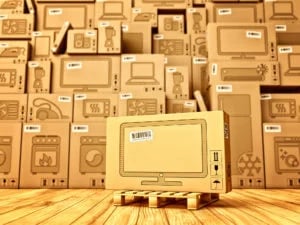
Next to glassware and other fragile items, electronics might be the most challenging (and misunderstood) products to ship when it comes to delivery. This is largely because of the makeup of electronics items.
Specifically, these products are comprised of hundreds — perhaps even thousands — of tiny, fragile parts. If they're not cared for properly, they can become easily damaged from impact or moisture.
Think of it this way: If one component becomes damaged during shipment, no matter how seemingly minor the component may be, it could render the entire electronic product useless.
4 Steps to Safely Ship Electronics
Generally, here are the four steps that are crucial to shipping electronics safely:
- Separate
- Bundle and package components
- Invest in protective packaging
- Assemble in the box
1. Separate:
The first thing you'll want to do before packaging the product for shipment is separating it into as many pieces as possible.
Yes, this will mean that the end recipient may have to spend a few minutes assembling it upon delivery, but it's the best way to ensure safe transit.
2. Bundle and Package Certain Components:
Are there small components that you'll be shipping as part of the product? Be sure to invest in some secondary packaging and secure these components in their own special plastic bag.
Just be sure that the bags are labeled with the type of component that they're holding.
3. Invest in Protective Packaging:
Like we noted in the opening, electronics can be a difficult category of product to package and ship due to their fragility.
On this note, we strongly advise investing in the right type of protective packaging solution to help secure items and prevent them from jostling around when in transit.
Some ideal protective packaging formats to consider include retention and suspension packaging (ideal for television sets), foam packaging, air cushion packaging, molded pulp trays and corrugated flutes or box partitions. In many cases, protective packaging can be custom designed and made to cater to specific or unique applications.
4. Assemble Within the Box:
Now that you've bundled certain components in plastic bags and have the right type of protective packaging to prevent product damage while in transit, it's time to carefully assemble the product and its secondary packaging into a corrugated box.
Once the product is placed in the box, it should not move around at all if it's secured properly. Be sure to also place a label on the box to warn of the product's fragility and inform workers not to stack other products on top of the box.
Take Electronics Shipping Seriously
It doesn't matter how good of a product your company has designed and manufactured if it doesn't get to the end user in one piece. It's why a brand's reputation hinges on much more than the products it creates.
On this note, be sure that you know the proper steps to follow to get your electronics from your warehouse to the consumer in a safe and secure way.
Failure to take the proper steps into consideration will only hurt your brand — and your bottom line.
Shop protective packaging products now:
.png?width=845&height=137&name=Slice%203%20(23).png)